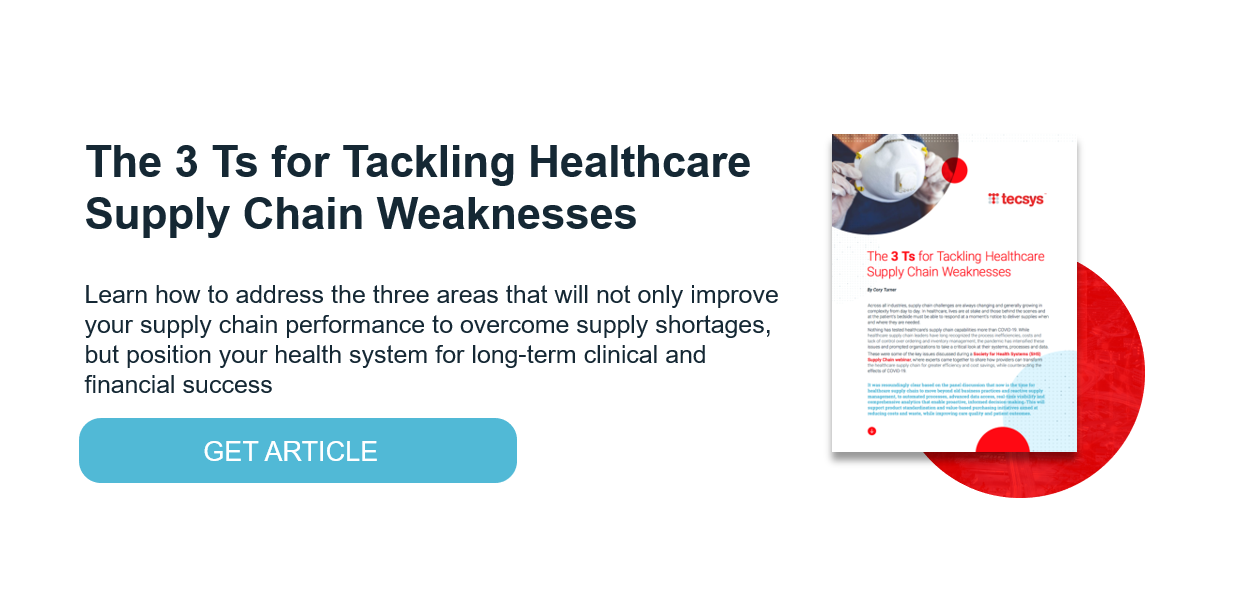Do You Have Confidence in Your Hospital Inventory Management Data?

In the vast majority of U.S. hospitals, medical/surgical supply inventory is typically managed outside of clinical processes, each with their own silo of systems and data. While the supply chain department is working to procure supplies and manage them, clinical teams are using the supplies on patients and documenting their use in the electronic health record (EHR), but neither party has visibility into what the other is doing.
At the patient’s bedside, clinicians typically don’t have access to information on supply levels and availability, where items are located within the facility, or product expiration dates. When clinicians have a patient on the table and find they don’t have what is needed for the procedure, there are frantic calls to supply chain managers asking, “Where is this item. I need it now.”
Furthermore, when hospital inventory management and clinical data is housed in disjointed systems, executive leaders — clinical, supply chain, finance — do not have visibility into supply consumption information that is critical to informed decision-making. While a hospital has a record of its supply purchases in its enterprise resource planning (ERP) system, and documentation of products used in patient procedures in its EHR, there is no easy way to integrate and analyze this data for forecasting and demand planning or to determine how supplies impact care quality and cost.
Hospital Inventory Management Checklist
What is needed, say experts, is a set of technologies that in its totality does several things:
- Documents accurately and clearly physician orders in the EHR and connects those clinical orders to supply and other needs in another electronic system.
- Organizes information around physician preferences into a usable system for joint use by clinical and non-clinical staff.
- Connects EHR orders, pick lists and data analytics, to allow for all interested parties to analyze physician supply choices and enable collaboration around optimizing supply inventories.
- Moves decision-making and analytics to as near to real-time decision-making and analysis as possible.
- Ultimately, helps hospital organizations to automate resupply and reordering processes, reduce supply costs and facilitate greater accuracy in the overall process.
Where to Start?
The most significant opportunity for end-to-end hospital inventory management is in the perioperative space. While surgical cases are the greatest revenue driver for hospitals, the operating room (OR) is also the area of highest supply expense. By automating resupply and reordering processes, a hospital can improve the accuracy of supply replenishment, helping to ensure items are available when needed.
This in turn can drive more accurate and up-to-date physician preference cards, minimizing the risk that unneeded products are picked for a case and go unused. Improved inventory management can also boost revenue and lower costs by preventing surgical case delays/cancellations and reducing supply overordering, hoarding and expired/wasted products.
In today’s value versus volume healthcare reimbursement environment, perhaps the greatest benefit of supply chain and clinical data integration is the ability for a hospital to determine the true cost of care. An organization can clearly see which products a physician used for a procedure, the cost of those supplies and the patient’s outcome (e.g., any complications, length of stay, readmissions). From there, healthcare supply chain can present this data to clinical leaders to help standardize on the products and processes that deliver the best outcomes at the lowest cost. A clinically integrated supply chain moves decision-making and analytics to near real time for greater efficiency, accuracy and cost savings.
Prepare Your Hospital for Sustainable Cost
In order to gain centralized, comprehensive control of your supply chain, I suggest you take time to pinpoint your hospital inventory management issues and where there are gaps in your processes and data.
Ask yourself:
- Do you have end-to-end visibility from supply procurement through to patient use?
- Are your processes automated or are your clinical staff members still conducting manual counts in the OR and stickering chargeable items?
- Do you have confidence in the accuracy, timeliness and completeness of your hospital inventory management data?
Tecsys’ healthcare supply chain solutions can help you gain inventory visibility, reducing the need for time-consuming manual intervention and giving you vital insights into consumption levels by product. Our applications will give you extensive, accurate utilization and cost data — empowering you to make confident business decisions.




